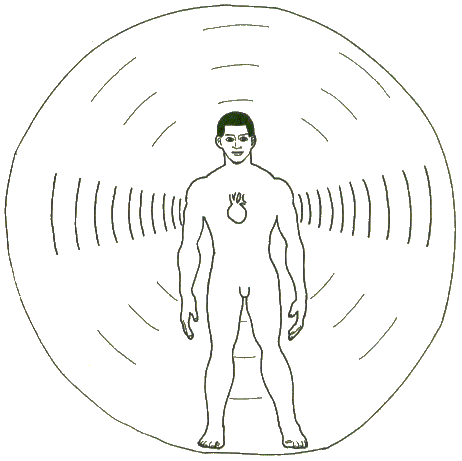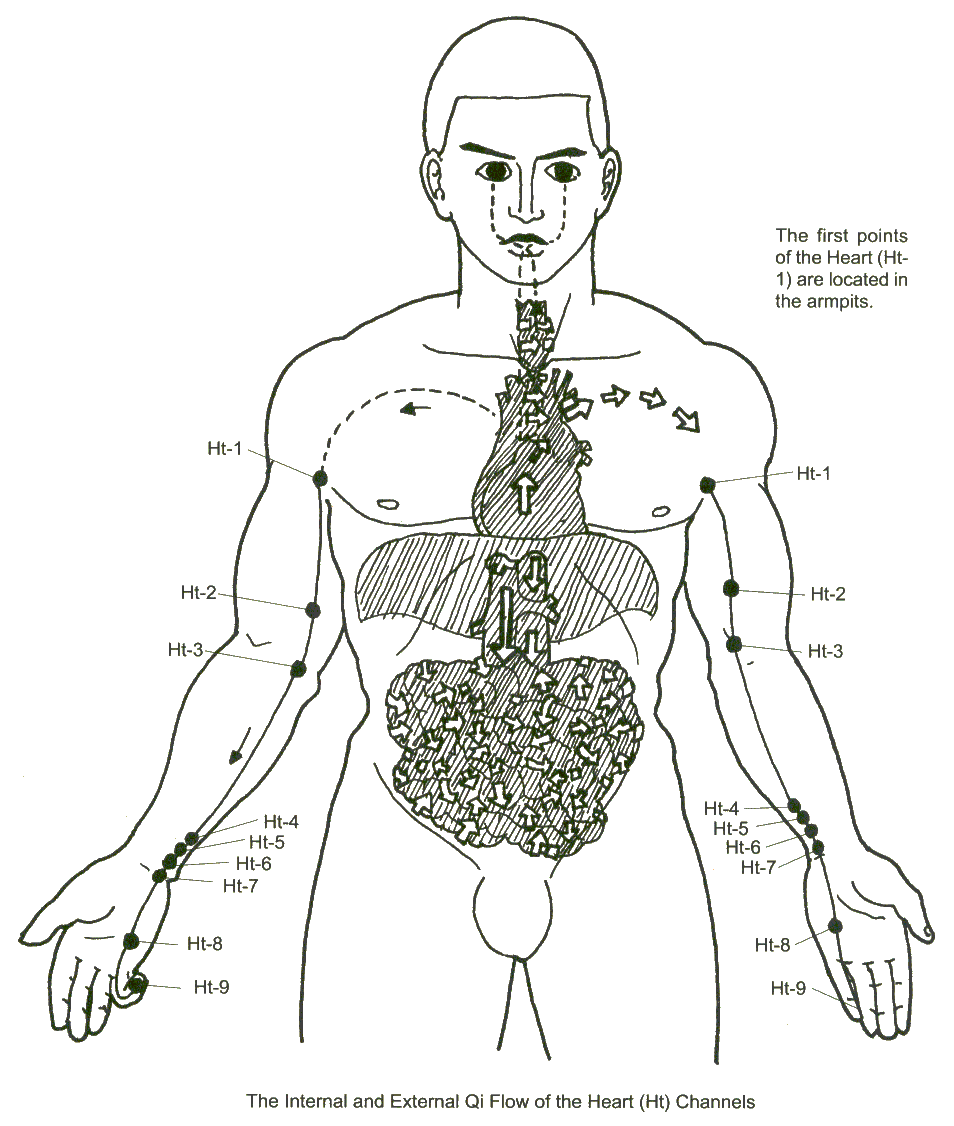
Heart: Fire-energy yin organ

Heart:
Fire-energy yin organ
The heart is called the 'King' of the organs. The Internal Medicine Classic states: 'The heart commands all of the organs and viscera, houses the spirit, and controls the emotions.' In Chinese, the word for 'heart' (hsin) is also used to denote 'mind'. When the heart is strong and steady, it controls the emotions; when it is weak and wavering, the emotions rebel and prey upon the heart-mind, which then loses its command over the body.
Physiologically, the heart controls the circulation and distribution of blood, and therefore all the other organs depend upon it for sustenance. Thoughts and emotions influence the function of various organs via pulse and blood pressure, which are controlled by the heart, where emotions arise. Internally, the heart is functionally associated with the thymus gland, which is located in the same cavity and forms a mainstay of the immune system. Extreme emotions such as grief and anger have an immediate suppressive effect on the immune system by inhibiting thymus function, a phenomenon that has long been observed but little understood in Western medicine.
Externally, the heart is related to the tongue, to which it is connected by the heart muscle. The color and texture of the tongue thus reflect the condition of the heart. Speech impediments such as stuttering and mutism are often caused by dysfunction or imbalance in heart energy. Facial complexion, which is a direct reflection of blood circulation, is also a major external indicator of heart function. Fire energy makes the heart the dominant organ of summer, during which season the heart must increase circulation to the surface in order to dissipate excess body heat.
|
Heart-Mind |
|
| Paired Organ | Small Intestine |
| Color | red with slight blue tint |
| Peak Hours | 11am-1pm |
| Physical Branches | blood, tongue, throat, sweat, facial complexion, adrenals, thyroid, prostate, pituitary |
| Functions | pulse/circulation, house of the spirit |
Heart: Psycho-Emotional Aspects
The Heart's associated organ is the Small Intestine; its element is Fire. Long-term memory, thinking, emotions, intimacy, cognition, intelligence, and ideas are all dominated by the function of the Heart. The Heart is sometimes called The Emperor, or "supreme controller of all Yin and Yang organs". The Heart houses the body's spirit (Shen). The Heart dominates sleep; if the Heart is strong the patient will fall asleep easily and sleep soundly. If the Heart is weak, the patient's mind will "float," resulting in an inability to fall asleep, disturbed sleep, or excessive dreaming. The Heart's positive psycho-emotional attributes are love, joy, peace, contentment, propriety, insight, wisdom, orderliness, forgiveness, and courtesy. Its negative attributes are hate, guilt, shock, nervousness, excitement, longing, and craving.

... It is only recently that the intelligence system of the heart has been discovered. The heart is not just a pumping machine. It is an intelligence system. It is in fact the most intelligent system of all our brains, with its own receptors, its own electromagnetic force, from 45 to 70 times more powerful than the brains of the neocortex, and the only force capable of changing our own DNA.It can turn the mortal into immortal, glial cells into heart cells, mortal center into immortal walls in any cell. It is in fact he heart that turns each one of us from dead into living cells. No one of us is human until the heart beats. And viceversa, that first beat of the heart is what makes us human. In summary we can affirm the following: a) The heart contains its own nervous system and nerve ganglia that process information and send it to the neocortex. b) Th heart is a hormonal gland producing its own neurotransmitters, dopamine, epinephrin, norepinephrin, the catechlomines, which affect the kidneys, the adrenal gland, the circulatory system and the neocortex. c) The heart generates from 45 to 60 times more amplitude electrically than what we call the brain, plus all emotions alter the heart's electrical field. d) Electricity emanating from the heart of person A can be detected and measured in the brain waves of persons near or touching person A. e) Cellular memory resides in the heart cells, as can be seen from transplant cases. f) DNA can be altered in the hands of a person practicing head/heart "entrainment," or what we know as yoga.
The second beat, and the first in what will determine our identity, is the
amygdala. The amygdala starts forming immediately after the heart's first beat.
It stores all the memories of our life in the womb, with the placenta, the
water, the fluids of life and the terror of losing them, and also the joy of
being fed, of bouncing, of moving. But the amygdala stores also the life of the
mother, her depressions, her fears, her life. And this accumulation of memories
goes on in us till the age of three. Which means that all this time we have
lived, our life has been recorded for us in the amydgala. After the age of three
the hippocampus matures in us. In it conscious memories are stored and we have
access to them However, the hippocampus, we, have no access to the memories and
the life we lived in the amygdala of the previous three years, even if from this
point on amygdala and hippocampus converse with each other ( Carter, Rita,
1998). What happens to the memories of the amygdala? They become our individual
nightmare, the invisible conditioning of all our actions, the blind spot of our
lives, the origin of all our terrors, the unknown reason why we do what we done
even when we do not know why we do it. And this is the
reason why there is karma, and why we speak of previous lives, and we create,
those vengeful gods waiting to destroy us around every corner, and the faces of
the gods are so distorted and our bodies are paralyzed with fear and inaction.
And this is why there is yoga. Can we distroy these nightmares to which we have
no access to, can we change those distorted faces of the gods, can we dissolve
our conditioning? The answer is, of course, yes, and the path is YOGA. And this,
why? Because the conditioning of the amygdala can only be removed by the
intelligence system previous to it, and this is the heart, with its
electromagnetic force and its power of transformation. Otherwise, the amygdala
can act on its own by passing the intelligence centers of the neocortex. The
gunas keep acting in spite of our good intentions. We live in vain tied to the
wheel of samsara.

The Heart Channel Pathway, Acupuncture Points, and Internal Trajectories
This channel begins at the heart and emerges via the surrounding blood vessels to pass down through the diaphragm to the small intestine. Another internal branch extends through the throat to the eye, and a connecting channel goes to the tongue. A third branch goes first to the lung before surfacing at the center of the armpit. From here the channel descends along the inner aspect of the arm on the opposite side of the biceps to the lung channel, passing the inner end of the elbow crease. It continues down to the tip of the little finger by the corner of the nail on the thumb side.

Internal Trajectories of the Heart Meridian
The heart, hand shao yin vessel, starts at the center of the heart, comes out and permeates the supporter of the heart, goes down to and spirally wraps the small intestine. A branch following the supporter of the heart surrounds the throat and passes up to and makes contact with the supporter of the eye. The main meridian following the supporter of the heart goes up to the lungs, comes out below the armpit, and then starts at HT-1.
The heart meridian has its origin in the heart itself, but does not permeate the heart, rather it permeates the "supporter of the heart", probably the aorta and other major blood vessels entering and exiting the heart. Following the descending abdominal aorta, the descending part of the small intestine, spirally wrapping the small intestine. The branch that passes upwards, surrounding the throat, and going to the "supporter of the eyes" (the optic nerve), probably follows the blood vessels passing up into the head, i.e., the carotid artery. The main meridian passes from the "supporter of the heart," probably along the pulmonary artery, to the lungs and thence to the side of the body, exiting at HT-1. A passage from the Su Wen tells us how the heart and uterus are related:
When the menstruation doesn't come, it means that the blood vessel of the uterus is stagnant. The vessel of the uterus, belonging to the heart (meridian), spirally wraps the inside of the uterus. In this case, qi rises up and presses the lungs from the lower parts. The heart qi cannot pass down smoothly, therefore the menses do not come.
There are several important distinctions regarding the heart meridian trajectory. The heart meridian does not permeate the heart itself, rather it permeates the "supporter of the heart", which becomes the descending abdominal aorta. This vessel is palpable as the moving qi between the kidneys. The energetic consequences of this distinction are enormously important. We feel that this is making a very direct statement about the energetic nature of the heart, especially about the relation of the heart to the blood and to the Shen. As we shall see later in this text this has a major influence on how we understand the nature of the source, the source qi, the moving qi between the kidneys, and ultimately the way in which the authors of the Ling Shu understood the origins of life. The relationship between the heart and the uterus is very significant. Some authors see the uterus as the place where the moving qi between the kidneys resides. This tends to reinforce the energetic connections that the heart has to this source. Further, it is the superficial trajectory of the supporter of the heart that is the main meridian. This is possibly one reason why many great practitioners have consistently refused to treat the heart meridian directly.